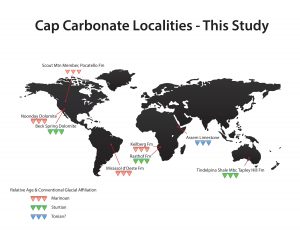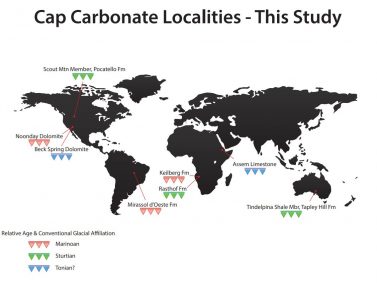The Snowball Earth: Mapping Oceanic Redox Variations during Neoproterozoic Sturtian and Marinoan Deglaciation
Project Summary
The Snowball Earth Hypothesis comes from evidence of two severe glaciation periods on Earth during the Neoproterozoic era known as the Sturtian (~717-659 Ma) and the Marinoan (~645-635 Ma) glaciations. During these glacial periods, geologic evidence has suggested the possibility of glacial ice sheets extending to the equator. Extensive glacial ice sheets may have restricted the interaction between the ocean and the atmosphere causing restrictions in the hydrologic cycle and changing seawater chemical composition. Evidence of cap carbonates worldwide suggests rapid changes towards greenhouse conditions once the atmosphere-ocean interaction resumed after millions of years-long intervals. Atmospheric CO2 gradually increased from volcanic outgassing during these glacial periods, causing melting of low latitude ice sheets, which resulted in a global albedo decrease assisting with continuous melting of glacial ice sheets.
The purpose of this study is to develop two analytical methods (solution ICP-MS and LA-ICP-MS) to obtain elemental geochemistry and create chemostratigraphic correlations across different localities. The study’s objective is to examine whether cap carbonates from different locations across the globe during specific glacial episodes (Sturtian & Marinoan) were deposited under similar or different environmental conditions. Major, minor, and trace element concentrations are evaluated to assess mineralogic composition (limestone vs. dolostone: Ca & Mg), sample preservation representing primary deposition (Al, K, Si), and redox proxies in seawater (Y and REEs).
This study proposes that most cap carbonates contain mostly a mineralogy composition of dolomite (MgCO3) as opposed to calcium carbonate (CaCO3). About ⅓ of the samples analyzed in the study show potential of poor preservation due to post-diagenetic alteration, with post-Sturtian samples being affected the most. Rare Earth Elements geochemical analyses focusing on Ce and Eu anomalies for this study suggest that locations during Pre Sturtian lack a Ce anomaly and show a minor positive Eu anomaly exhibiting consistency with oceanic anoxia during this time. There is variation in localities during the Syn-Sturtian and Post-Sturtian due to Ce and Eu anomalies showing anoxic conditions in some localities (Scout Mountain member and TIndelpina shale) and oxygen-rich conditions in other locations (Rasthof Formation). The Post-Marinoan exhibits oxygenated environments across localities due to lacking a Ce anomaly and containing a slight negative Eu anomaly. With these results, evidence shows that oceanic conditions during glaciation periods were homogenized during their perspective, time periods for the most part except for regional variations.

Above image: Field sample of the basal Rasthof Formation cap carbonate, which directly overlies Sturtian glacial deposits of the underlying Chuos Formation, in northern Namibia. Serial vertical sections of this sample reveal a dolostone dropstone clast, presumably transported from glacial erosion of the underlying carbonate shelf. The dropstone likely represents pre-Cryogenian seawater deposition whereas the surrounding, variably laminated, cap carbonate matrix represents deposition during rapid deglaciation and the significant resumption of ocean-atmosphere exchange.
The Snowball Earth: Mapping Oceanic Redox Variations during Neoproterozoic Sturtian and Marinoan Deglaciation
Project Summary
The Snowball Earth Hypothesis comes from evidence for two severe, multi-million year long, glaciation intervals on Earth during the Neoproterozoic Era. These glacial intervals, known as the Sturtian (~717-659 Ma) and the Marinoan (~645-635 Ma) glaciations, are considered to have been global in extent (panglacial) and collectively define the Cryogenian Period. These glaciation events are significant in Earth history as they occurred during a second major oxygenation event known as the Neoproterozoic Oxidation Event (NOE); the first major oxygenation event, known as the Great Oxygenation Event (GOE), occurred at the Archean-Proterozoic boundary. During Neoproterozoic glacial periods, geologic evidence suggests that ice sheets may have extended to the equator. Such extensive ice sheets would have restricted the interaction between the ocean and the atmosphere, dampened the hydrologic cycle and extent of silicate weathering, and changed the chemical composition of sea water to a more reducing state. The worldwide occurrence of cap carbonate successions, immediately following deposition of Cryogenian glacial deposits, suggests deglaciations were associated with rapid changes towards greenhouse climate conditions. Tremendously high atmospheric CO2 levels, built up slowly from volcanic outgassing over millions of years, are thought to have triggered melting of low latitude ice sheets, which decreased global albedo and stimulated rapid and continuous melting of glacial ice sheets.
The purpose of this study is to develop two analytical methods (solution ICP-MS and LA-ICP-MS) to obtain elemental geochemistry and create chemostratigraphic correlations across different localities. The study’s objective is to examine the redox state of shallow marine environment’s carbonate precipitation following Neoproterozoic glacial episodes by evaluating carbonates from different locations across the globe during specific glacial episodes (Pre-Cryogenian, Sturtian, and Marinoan) and determine similar or different environmental conditions. Major, minor, and trace element concentrations are evaluated to assess mineralogic composition (limestone vs. dolostone: Ca & Mg), sample preservation representing primary deposition ( Ca/Mg vs. Al, K, Si, Mn, Fe), and redox proxies in seawater evaluating Yttrium and Rare Earth Elements (REEs).
In this study, we find that most cap carbonates contain mostly a mineralogy composition of dolomite CaMg(CO3)2 as opposed to calcium carbonate (CaCO3) except for the Assem Limestone, and Scout Mountain Member. About one-third of the samples analyzed in the study show potential of poor preservation due to post-diagenetic alteration, with post-Sturtian samples being affected the most. Rare Earth Elements geochemical analyses focusing on Ce and Eu anomalies for this study suggest that Pre-Cryogenian locations lack a Ce anomaly and show a minor positive Eu anomaly exhibiting consistency with oceanic anoxia during this time. There is variation in localities during the Syn-Sturtian and Post-Sturtian due to different Ce and Eu anomalies showing anoxic conditions in some localities such as Scout Mountain Member and Tindelpina Shale (lack of Ce and slight positive Eu anomalies), and oxygen-rich conditions in other locations such as the Rasthof Formation (negative Ce and positive Eu anomalies). The Post-Marinoan exhibits oxygenated environments across localities due to negative Ce anomalies and non-existent or slightly negative Eu anomalies. With these results, evidence shows that oceanic conditions during glaciation periods were homogenized during their perspective time periods for the most part except for regional variations.

